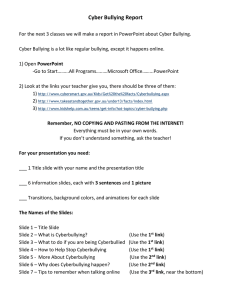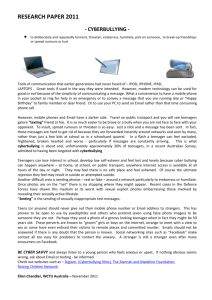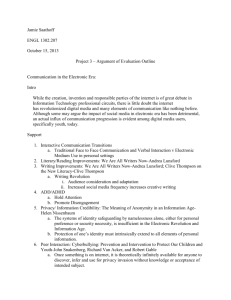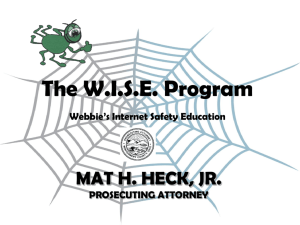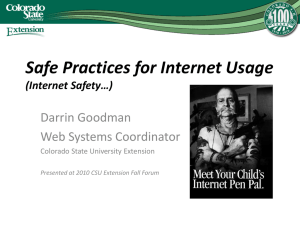Internet Safety - Eastern Upper Peninsula ISD
advertisement
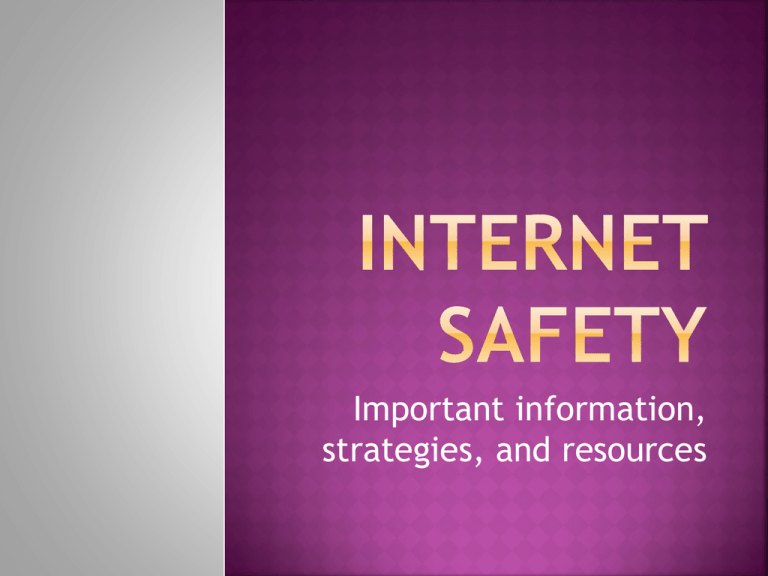
Important information, strategies, and resources Barb Light EUPISD BTOP Project Director Suzy Belonga Instructional Technologist LaSalle High School Northern Michigan University Elementary Education and English, 2001 Northern Arizona University Masters in Educational Technology, 2010 Twin Peaks Elementary Second and Fourth grade teacher “The Future of Screen Technology” Internet statistics Changing Student perspectives Internet statistics “Tracking General Teresa” from NetSmartz.org Internet safety tips Cyberbullying Focusing statistics and tips on Facebook Questions and resources http://news.bbc.co.uk/2/hi/technology/8552410.stm http://news.bbc.co.uk/2/hi/technology/8552410.stm http://news.bbc.co.uk/2/hi/technology/8552410.stm Google had almost 350 million unique users. http://news.bbc.co.uk/2/hi/technology/8552410.stm socializing & communication entertainment research education Facebook, Twitter, chats, blogs, cell phones, email, texting, IMs Online movies, TV. shows, games news, Google, libraries, museums Online classes, remediation, enrichment 78% of teens report that they have been using the Internet for three years or more More than half say they have been on the Internet for five or more years. 80% say they used the Internet “yesterday.” 90% of 10- to 12-year-olds say their parents know where they are going online, 41% of 13- to 15-year-olds. Only 7% of 10- to 12-year-olds say their parents think they know their children’s online destinations but really don’t. 27 % of 13- to 15-year-olds report that their parents think they know online destinations but don’t. “Teen and Cyberbullying: Executive Summary of a Report on Research” by National Crime Prevention Council (NCPC), 2007 96% of teens have an email account 79% of teens use the Internet at school for school-related research 51% of teens surf the web at school 34% percent send and receive email at school 42% use the Internet at a friend’s house 33% use the Internet in other places 75% send Instant Messages (IMs) 60% read or post messages on blogs or similar websites 23% visit online chat rooms 43% report that their parents usually know what they are doing online, but do not have any rules about their activity. 31% report that their parents have rules about their online activity 8% report that they find ways around their parents’ rules 23% report that they follow the rules. “Teen and Cyberbullying: Executive Summary of a Report on Research” by National Crime Prevention Council (NCPC), 2007 • 61% of 13 to 17 yr. olds have a personal profile on a social networking page. • 71% report getting a message from somebody they don’t know. • • 40% said they usually reply. 18% said they would talk to an adult. • 30% have considered meeting someone that they’ve only talked to online. • 37% said they were not concerned about their private information being used online in ways they don’t want. Teen Internet Safety Study by Cox Communications and NCMEC2, found at NetSmartz.org Protect yourself online! When is it okay to post a • • Think about what you are posting. Nothing is completely private when you write it online. picture of others online? a.) any time you want Colleges/universities and employers are looking. b.) after you show it to • Respectyour others parents. online: keep it appropriate. once you have the • Delete c.) unknown e-mails with attachments. permission of everybody in • Phone numbers, addresses, videos, travel plans, it. names, etc. should be kept private. real • Keep account IDs and passwords safe. • Be creative with screen names. • MHALLIFWWAS11@something.com • RARVAB6@nothing.com • Unsure? Log off and talk to a trusted adult! • Keep the computer in a central location. • Set time limits. • • Time to play and a time to work. Time to get up and move! • Communicate often and lay out expectations. • Be the student. Have your student teach you • what a blog, tweet, post, etc. is. Video networking. • • Visit the sites: only self-policing. Set expectations for uploading, viewing, etc. • • • • • • Understand and try their online games Visit Netlingo.com and learn the acronyms: CUWTA, CD9 or 9, F2F, KPC, LMIRL, TAW, IHA or TMA Expectations for online shopping Respecting copyrights Netiquette Be aware of cyber bullying Keep computers in a central place. Know where your children go online. Teach Internet safety: Use privacy settings and sharing controls Protect passwords Beware of strangers Help prevent viruses. Teach your children to communicate responsibly. View all content critically. Just because you see it online, there’s no guarantee it’s true. http://www.google.com/familysafety/tips.html Social Networking Know their password (non-negotiable) Set privacy settings Befriend their friends Look at their page and their friends’ pages Check their status updates Talk about what you see…do you think that is appropriate? Why or why not? Make it a teachable moment. “If it is not something I should see, then it shouldn’t be in writing!” Cell Phones Have a “no delete” rule. You delete their messages. Check their text messages (inbox ,outbox, SMS pictures) Have a cell phone curfew All cell phones charged in a central location (kitchen) Take cell phones away for sleepovers Check history on internet applications Make it a teachable moment. http://www.generationtextonline.com/cyberbullying-solutions-for-parents Good Topics to Discuss with your Children text messages can be interpreted differently then you meant it to be forwarding text messages can have negative consequences the legal and personal consequences of sexting that what you thought of as a “joke” can be extremely hurtful to others creating fake Facebook pages or posting mean comments are very hurtful that any picture I post on-line can be searched for, copied and pasted anywhere on-line that Facebook and Google save every picture I put on-line, even if I delete it right away no text message or Facebook post is ever totally deleted…if police need to find it, they can Monitoring Software K9 Web Protection – www.k9webprotection.com K9 Web Protection is a free Internet filtering and control solution for the home. K9 puts YOU in control of the Internet so you can protect your kids. Compatible with Windows & Mac. Mobile Spy – www.mobile-spy.com Silently record every SMS message. View information about every call. See GPS positions every thirty minutes. View all photos and videos taken by the phone. Compatible with BlackBerry, iPhone, iPad, iTouch, Windows & Android Phones eBlaster – www.eBlaster.com Monitor the online activity of your children from anywhere in the world: at work, in another room of your home, at an Internet Cafe, on vacation - even if you're thousands of miles away. Settings, Controls and Limits Use Facebook’s privacy controls to give you the power to decide what and how much personal information your children share with the world. Set the security settings within instant-messaging programs to control who contacts your children. The American Academy of Pediatrics recommends no more than 1 to 2 hours of television programming, which includes screen time on the computer. Set up some simple rules for your kids to follow while they're using the Internet. Both you and them should sign this contract and hang it in a common area. Where are kids bullied? What percentage of teens discuss Internet safety with parents? 36% SOURCE: U.S. Department of Justice, Bureau of Justice Statistics, School Crime Supplement (SCS) to the National Crime Victimization Survey, 2007. Most effective ways to prevent cyberbullying: being able to block people (71%) refusing to pass along cyberbully messages (62%) tell friends to stop cyberbullying (56%) 56% believe that online groups and Internet service providers (ISPs) should have the moderators who can block cyberbullies’ messages 45% of teens say that parents should tell their kids that cyberbullying is wrong 43% say that cyberbullying should be reported to an adult Do not view cyberbullying as an issue that should be addressed by the school. Feel much of customary school intervention (large assemblies, etc.) would be largely ineffective. “Teen and Cyberbullying: Executive Summary of a Report on Research” by National Crime Prevention Council (NCPC), 2007 Bully-proofing Your Child Help your child understand bullying. Keep open lines of communication with your child. Encourage your child to pursue their interests. Teach your child to take a stand against bullying. Talk to your child about seeking help from a trusted adult when feeling threatened by a bully. Know what is going on in your child's school. http://www.stopbullying.gov/parents/bully_proofing/index.html http://www.stopbullying.gov/community/tip_sheets/index.html http://www.stopbullying.gov/topics/get_help/index.html www.cybertipline.com Facebook privacy and safety pages Suzy’s links: http://www.diigo.com/list/suzybelonga/internetsafety Microsoft’s “Age-based guidelines for kids' Internet use” http://www.microsoft.com/protect/parents/childsafety/age.aspx BTOP: www.tinyurl.com/eupbtop NetSmartz: www.netsmartz.org U.S. government: stopbullying.gov Cyber Tip line: www.cybertipline.com Take the Challenge: http://www.takethechallengenow.net/ Get Net Wise: www.getnetwise.org National Cyber Security Alliance: www.staysafeonline.org Wired Safety: www.wiredsafety.org

